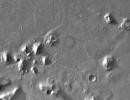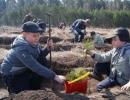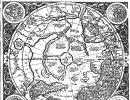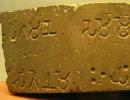Riddle of 7 bridges of koenigsberg solution. Seven bridges of koenigsberg. Wooden bridge. View of the island of Kneiphof
For more than 10 years, the newspaper “Novye KOLESA Igor RUDNIKOV” under the heading “Walks around Koenigsberg” has been publishing articles on the history of our city. Out of more than 500 essays-walks for the book, we chose 34 - sad and funny, tragic and epic. The chapters contain sketches of the customs and life of the Königsbergers, based on historical facts, legends and legends: fashion and architecture, police, military and firefighters, restaurants and cafes, university and schools, the historical connection of Koenigsberg with Russia and much more ... Photos of Koenigsberg and illustrations by the artist S. Fedorov, made especially for this book, will give us the opportunity imagine this city-“Atlantis”.
Seven bridges of Königsberg
Euler's problem was solved by war and Soviet authority
It is known that the great Swiss mathematician Leonhard Euler created a whole branch of science by solving the problem of seven Königsberg bridges.
In vain trample shoes
There is a legend that the inhabitants of Koenigsberg loved to walk along the streets of three medieval cities “merged” into a single whole: Altstadt, Löbenicht and Kneiphof, but they could not stand to trample their shoes in vain. These cities were connected by seven bridges. And now, as if economical townspeople once thought: is it possible to go through all the bridges so that you visit each of them only once and return to the place where you started the walk?
Euler was interested in the problem. “No one has yet been able to do this, but no one has proven that it is impossible ... Neither geometry, nor algebra, nor combinatorial art is sufficient for the solution,” he wrote to his colleague, an Italian mathematician and engineer.
Finally, building the most complicated algorithm, Euler received a negative answer. It turned out to be impossible to cross all the bridges only once and, having described the circle, return to the starting point.
Shop, Green and Blacksmith
So, the Lavochny Bridge (Kremerbrücke) was the oldest. It was built in 1286 on the initiative of the mayor of Altstadt (who had just received city rights). He connected Altstadt with the island of Kneiphof, which did not yet have an urban settlement.
A booth was built next to the Shop Bridge - as it is written in German papers, "for storing possible rubbish." In 1339, the bridge is mentioned as named after St. George, but in 1397 it acquires a new name: Kogenbrücke, that is, the Bridge of Ships (merchant ships were then called Kogami in the Hansa). In 1548, this name became official, changing to one letter: Kokenbrücke.
In 1787 the bridge was reconstructed. The "junk box" was removed. In 1900, a new one, made of metal, was built in place of the wooden Kokenbrücke. He safely survived the war and was demolished in 1972 during the construction of the Estakadny Bridge.
Shop bridge and old port warehouses
Gut bridge
Next - Green (Grunebrücke). It was built in 1322 across a branch of the Pregel River in order to provide traffic from the suburbs of Ponart to the Royal Castle. Burned down in 1582. Six years later it was rebuilt, again from wood. It existed in this form until 1907, then it was replaced with a metal one, it was adjustable. The mechanism was set in motion manually. Survived the war. “Sentenced” to him in the same 1972, during the construction of the Overpass.
In 1379, on the initiative of the Altstadters and by the decision of the master of the Teutonic Order Winrich, a bridge was built parallel to Lavochny. It was named Blacksmith (Schmidebrücke). He also had a booth "for trash."
By 1787, the Blacksmith's Bridge was dilapidated and was replaced with a new one, also made of wood. It was built in metal in 1846. Instead of a booth, they put a turret for a steam installation - an adjustable mechanism.
During the assault on Königsberg, it was destroyed and never rebuilt.
Offal, Tall and Wooden
The Offal (Meat) Bridge (Kettelbrücke) ran parallel to the Green Bridge, located near the slaughterhouse, in front of the Stock Exchange building (now the Sailors' Palace of Culture). It was built in 1377 at the expense of the inhabitants of Kneiphof to connect them with Vorstadt - the warehouse area. There, in Vorstadt, stocks of wood for heating were initially stored.
Partially, the Gut Bridge was destroyed even before the storming of the city in April 1945, and its spans were used to repair the Wooden Bridge (Halzbrücke). Wooden intact to this day, it connects the former Altstadt with Oktyabrsky Island (former Lomse Island). If you look closely, you can see that the forging of the railing is different: in some places its elements are oak leaves, in others, borrowed from Potrokhovy, there are rings.
In 1377, permission was obtained for the construction of the High (Hoebrücke) bridge (connecting Oktyabrsky Island with the current Dzerzhinsky Street). AT late XIX century, its wooden version was replaced by a building made of brick and metal. By the way, next to this bridge is the only surviving building of lifting mechanisms in the whole city - a turret called the Bridge House. (She was about to fall into the Pregel, but a few years ago she was restored.)
In 1937, a new metal and concrete bridge was built just to the east. It is he who exists to this day. True, since then it has not been modernized, although, according to the plan, all the bridges of Königsberg were to undergo ongoing reconstruction.
Or maybe it's for the best? Eyewitnesses recall how in 1996, sappers - ours, from Kaliningrad - blew up the concrete coating with heavy bombs while repairing the Trestle Bridge! Moreover, structures of this kind are very sensitive not even to a shock wave, but simply to a synchronous oscillation. After all, there is a case when a rather strong bridge collapsed from the fact that a company of soldiers walked along it in the foot ...
Imperial and Honey
The Honey Bridge (Honigbrücke), built in 1542, has also been preserved. According to legend, it owes its “delicious” name to ... a bribe that Ober-Burgrave Basenrade allegedly received from the Kneiphof City Council. For permission to build a bridge linking Kneiphof with the island of Lomse, bypassing the Altstadt. It was as if the Kneiphofers had delivered a whole barrel of honey to Bazenrad, and the angry Altstadters called them “honey lickers” for this.
One way or another, Medovy survived World War II. And now it leads to the Cathedral from Oktyabrskaya Street. He was almost killed by a barge called "Scarlet Sails" - remember, there was such a floating restaurant on Pregol. During a strong wind, the barge was torn off the anchor and she rammed her bow into the railing of the bridge. Right in the center. But ... local craftsmen successfully solved the problem with the help of an autogen. And the barge was dragged for scrap.
…Other Königsberg bridges appeared much later and have nothing to do with the Euler problem.
Thus, the Imperial Bridge (Kaiserbrücke) built in 1905 connected the island of Lomse with Vorstadt. Partially the bridge was damaged during the war. One of its spans was preserved until the mid-eighties, and then it was scrapped.
Railway and Berlin
The Old Railway Bridge connected the old South and East stations with the Altstadt warehouse district. In 1929, it was recognized as emergency, after four years it was dismantled. And after the war, the first settlers restored the bridge, although not in its former form.
New Zheleznodorozhny - better known as a bunk - was blown up by German sappers during the assault on Königsberg. Soviet sappers "pointed" him immediately after the war. He divorced then, not rising up with both halves, but “driving apart” to the sides by turning.
By the way, it was he who remained in the history of Soviet cinema. In the film "Meeting on the Elbe", which was filmed in Kaliningrad in 1948-1949, there is a shot of former friends and allies, Russians and Americans, crowding on both sides of the river - like the Elbe - and the Americans raise the bridge, thereby marking the beginning of cold war.
So, in the role of the "bridge over the Elbe" our bunk was filmed. They reconstructed it in the late fifties and made it rising.
But the Berlin (Palmburg) - the one behind the village of Borisovo, along the ring road towards Isakovo - froze in a "half-reduced" state. Just froze in a spasm. It was blown up in 1945, before the assault.
high bridge
During the reign of the first secretary of the regional committee of the CPSU Konovalov, one part of the bridge was reduced. The builders proceeded to the second, but from Moscow they angrily shouted at them: “Are you restoring Nemetchyna ?!” As a result, special equipment was sent for scrap, and the bridge remained ... a historical monument. General Koenigsberg-Kaliningrad history. Although restoring it is not a problem.
Monster across the avenue
... By the way, when the Trestle Bridge was being built, the width of its carriageway coincided with the total width of Lavochny and Kuznechny. It was cheaper to restore two parallel bridges - Kuznechny and Potrokhovy - and carry out traffic on them. But ... then megalomania reigned in everything, construction volumes were required.
Even funnier - and more tragic! - happened to that monster that sticks out across Moskovsky Prospekt. The architects - the authors of this "miracle" - claim that they acted on the basis of the German project for the reconstruction of Koenigsberg. Actually in German plans a completely different bridge was provided - from Kalinin Avenue to Lithuanian Val. And this place was chosen solely for mercantile reasons: many residential buildings fell under demolition, people needed to be resettled ... This means that new construction had to be carried out, this is a large amount of investment ... And the architect received a percentage of the shaft: the greater the amount of work, the more impressive the fee. And now ... we have what we have.
... In general, the Euler problem today has a completely different solution. On the remaining bridges in Kaliningrad, it is quite possible to describe a circle without repeating “simple movements”. That's just ... do you want to? And it's not even about the shoes.
Having considered this problem, in 1736 Euler proved that this is impossible, and he considered more common task: which areas, separated by river branches and connected by bridges, can be bypassed by visiting each bridge exactly once, and which ones are impossible.
Königsberg bridges">
Let's modify the problem a bit. Each of the areas under consideration, separated by a river, will be denoted by a dot, and the bridges connecting them by a line segment (not necessarily a straight line). Then, instead of a plan, we will simply work with a certain figure made up of segments of curves and straight lines. Such figures in modern mathematics are called graphs, segments are called edges, and the points that connect the edges are called vertices. Then the original problem is equivalent to the following: is it possible to draw a given graph without lifting the pencil from the paper, that is, in such a way that each of its edges is traversed exactly once.
Such graphs, which can be drawn without lifting the pencil from the paper, are called unicursal (from the Latin unus cursus - one way), or Euler. So, the problem is posed in this way: under what conditions is a graph unicursal? It is clear that a unicursal graph will not cease to be unicursal if we change the length or shape of its edges, as well as change the arrangement of vertices, so long as the connection of vertices by edges does not change (in the sense that if two vertices are connected, they must remain connected, and if they are disconnected - then disconnected).
If a graph is unicursal, then the topologically equivalent graph is also unicursal. Unicursality is thus a topological property of a graph.
First, we need to distinguish connected graphs from disconnected ones. Connected figures are such figures that any two points can be connected by some path belonging to this figure. For example, most of the letters of the Russian alphabet are connected, but the letter Y is not: it is impossible to move from its left half to the right by points belonging to this letter. Connectivity is a topological property: it does not change when the figure is transformed without breaks and gluing. It is clear that if a graph is unicursal, then it must be connected.
Second, consider the vertices of the graph. We will call the index of a vertex the number of edges that occur in this vertex. Now let's ask ourselves the question: what can be the indices of the vertices of a unicursal graph.
There can be two cases here: the line drawing the graph can start and end at the same point (let's call it a "closed path"), or at different points (let's call it an "open path"). Try to draw such lines yourself - with whatever self-intersections you want - double, triple, etc. (for clarity, it is better that there are no more than 15 edges).
It is easy to see that in a closed path, all vertices have an even index, and in an open path, exactly two have an odd index (this is the beginning and end of the path). The fact is that if the vertex is not the initial or final one, then, having arrived at it, you must then leave it - thus, how many edges enter it, the same number leave it, and the total number of incoming and outgoing edges will be even . If the initial vertex coincides with the final vertex, then its index is also even: how many edges left it, the same number entered. And if the starting point does not coincide with the end point, then their indices are odd: you need to leave the starting point once, and then, if we return to it, then exit again, if we return again, exit again, etc.; but you need to come to the final one, and if we leave it later, then you need to return again, etc.
So, for a graph to be unicursal, it is necessary that all its vertices have an even index, or that the number of vertices with an odd index is equal to two.
 |
Count the indices of its vertices and make sure that it cannot possibly be unicursal. That's why you didn't succeed when you wanted to bypass all the bridges...
The question arises: if there are no vertices with an odd index in a connected graph, or there are exactly two such vertices, then is the graph necessarily unicursal? It can be rigorously proven that yes! Thus, unicursality is uniquely related to the number of vertices with an odd index.
Exercise: build another bridge on the diagram of the Konigsberg bridges - wherever you want - so that the resulting bridges can be bypassed, having visited each exactly once; really do it this way.
Now another one interesting fact: it turns out that any system of areas connected by bridges can be bypassed if it is necessary to visit each bridge exactly twice! Try to prove it yourself.

| FORUM NEWS Aether Theory Knights | 01.10.2019 - 05:20: -> - Karim_Khaidarov. 30.09.2019 - 12:51: |
Shop Bridge, Krämerbrücke
Green Bridge, GrüneBrücke
Offal (Working) bridge, Koettel brücke
Blacksmith's Bridge, Schmitderbrüke
Wooden bridge, Holzbrücke
High bridge, Hohebrücke
Honey Bridge, Honigbrücke
Since ancient times, the inhabitants of Koenigsberg have struggled with a riddle: is it possible to pass through all the bridges of Koenigsberg, passing through each only once? This problem was solved both theoretically, on paper, and in practice, on walks - passing along these same bridges. No one was able to prove that this was not feasible, but no one could make such a “mysterious” walk along the bridges.
In 1736, the famous mathematician, member of the St. Petersburg Academy of Sciences Leonard Euler undertook to solve the problem of seven bridges. In the same year, he wrote about this to the engineer and mathematician Marioni. Euler wrote that he had found a rule by which it is not difficult to calculate whether it is possible to pass over all bridges and at the same time not pass through any of them twice. It is impossible to do this on the seven bridges of Koenigsberg.
It was thanks to this bridge problem that another bridge appeared on the map of old Königsberg, with the help of which Lomse Island was connected to the south side. It happened in this way. Emperor (Kaiser) Wilhelm was known for his simplicity of thought, quick reaction and soldier's "narrowness". At one of the receptions, where the Kaiser was present, the invited scientists decided to play a joke with him: Wilhelm was shown a map of Königsberg, offering to solve the problem of bridges. The task was obviously unsolvable. Wilhelm, to everyone's surprise, demanded a pen and paper, declaring that the problem was solvable and that he would solve it in a matter of minutes. Paper and ink were found, although no one could believe that Kaiser Wilhelm had the solution to this problem. On the submitted piece of paper, the Kaiser wrote: "I order the construction of the eighth bridge on the island of Lomse." The new bridge was called the Imperial Bridge or Kaiser-brucke.
This eighth bridge made the bridge task easy fun even for a child.... 
Dear HR, HR...
There is a famous mathematician, a member of the academies, probably a professor or even academician Euler, and there is simply Kaiser Wilhelm. Euler decided that the problem could not be solved, while Wilhelm showed in an accessible way that this was not the case. Sometimes disputes with you remind me of the above textbook example.
Well, I don’t want this woman to work for me anymore.
Because she turned out to be a bad worker.
But we can't fire her...
And why is that?
So after all ... an article is such and such, a section, a paragraph, a paragraph ...
I need an employee, not articles!
Read labor law...
I'm reading. I call and fire myself. And I understand that most of you will remain at the level of "article such and such, section, paragraph, paragraph ..."
When I was little (about 8 years old, probably), I went up to my father and asked: “Why is Kaliningrad called the city of seven bridges?” In response, he told me interesting story, laid everything out on the shelves. It was exciting and very educational. Naturally, I no longer remember this story in its original form, but I will try to tell it as excitingly as possible.
As you know, the city of Koenigsberg, founded in 1255, consisted of three independent urban settlements. They were located on the islands and banks of the Pregel River (now Pregol), which divides the city into four parts:
- Altstadt;
- Kneiphof;
- Lomze;
- Vorshtadt.
For communication between the city parts in the XIV century, bridges began to be built. Due to the constant military danger from neighboring Poland and Lithuania, the Königsberg bridges began to have a second function - defensive. In front of each of the bridges, a defensive tower was built with lockable lifting or double-leaf gates made of oak and with iron forged upholstery. The piers of some bridges had a pentagonal shape typical of bastions. Inside these supports were casemates, from which it was possible to fire through the embrasures.
All seven bridges of Koenigsberg were drawbridges. In connection with the decline of navigation along the Pregol, the bridges were no longer raised. The only exception was the High Bridge, which is periodically drawn apart to prevent the mechanism and wiring of masted ships.
There was a tradition: a guest of the city, in order to subsequently return to Königsberg, had to throw a coin into Pregel from one of the bridges.
Here is an interesting fact for you associated with tradition: during the cleaning of the Pregolya channel by a dredger in the nineties of the XX century, numismatist collectors literally fought for the right to stand with a sieve at the “gut”, from which bottom silt poured out.
And here is the second fact:"The problem of seven Königsberg bridges". The famous philosopher and scientist Immanuel Kant, walking along the bridges of the city of Koenigsberg, set the task: is it possible to pass through all these bridges and at the same time return to the starting point of the route so as to pass over each bridge only 1 time. Many have tried to solve this problem both practically and theoretically. But no one has been able to do this, and no one has been able to prove that it is impossible even theoretically.
In 1736, this problem interested the scientist Leonhard Euler, an outstanding and famous mathematician and a member of the St. Petersburg Academy of Sciences. He wrote about this in a letter to his friend, the scientist, Italian engineer and mathematician Marioni dated March 13, 1736. He found a rule, using which it was easy and simple to get an answer to this question of interest to everyone. In the case of the city of Königsberg and its bridges, this turned out to be impossible. But he managed to create a theory of graphs (mathematicians will understand), which is still used today.
You can also try to solve this problem. Here is a diagram of the city's bridges:

Let's figure out what these seven bridges are.
Krämerbrücke (Shop Bridge).
Considered the oldest of the seven bridges. It was built in 1286 to connect the city of Altstadt and Kneiphof, and at its entrance was a statue of Hans Sagan, the son of a Kneipch shoemaker. The legend said: during the battle between the troops of the Teutonic Order and Lithuania, Hans picked up the falling order banner from the hands of a wounded knight.

The name of the bridge was due to the fact that the adjacent banks of the Pregel, and he himself were a place of trade.

In 1900 it was rebuilt, and in 1972 it was demolished due to the construction of the Trestle Bridge.
Grünebrücke (Green Bridge).
The Green Bridge was built in 1322 and connected Kneiphof and Vorstadt. It got its name from the color of the paint, in which the supports and the superstructure of the bridge were traditionally painted.

In the 17th century, Green bridge the messenger handed out the letters that had arrived in Königsberg. In anticipation of correspondence, business people of the city gathered here, who, while waiting for the mail, discussed their urgent business. According to legend, it was for this reason that the first building of the Königsberg Trade Exchange was built near the Green Bridge in 1623.

In 1875, a new trading exchange building was built on the other side of the bridge, which has survived to this day. Now this building is the Palace of Culture of Sailors.

In 1907, the bridge was rebuilt, and in 1972 it suffered the same fate as the Lavochny Bridge: they were replaced by the Trestle Bridge.
Köttelbrücke (Working Bridge).
The working bridge was built in 1337. Connected Kneiphof and Vorstadt. Sometimes its name is translated as "Offal", which is associated with a slaughterhouse located nearby. From where the giblets were transported by swimming along the Pregel through this bridge.

Initially, the bridge was a drawbridge and consisted of three spans. In 1621, it was washed away by a flood and was rebuilt without a lifting mechanism.

During the development of Vorstadt in 1886, the Worker Bridge was rebuilt in stone and metal. He was given back the divorce function.

The bridge burned down during the Great Patriotic War and was demolished along with the bull supports in the 70s of the twentieth century.
Schmiedebrücke (Blacksmith's Bridge).
The blacksmith's bridge was built in 1397. Connected Altstadt and Kneiphof.

Blacksmiths were traditionally located near this bridge on the banks of the Pregel, apparently from this it got its name.

After the construction, the bridge took over part of the load from the parallel, slightly downstream, Lavochny Bridge. It was originally equipped with two stone pillars, covered with spans of boards, which were badly worn by 1787 and were replaced. In 1896, the Kuznechny Bridge survived the reconstruction and received decorative supports, steel spans and became a drawbridge. On the side of the Altstadt, a caretaker's tower was built, in which an installation was located for raising bridge spans using the water pressure of the city water supply, and the adjustable mechanism was controlled.

It was destroyed during the Great Patriotic War and was not restored after the war.
Holzbrücke (Wooden bridge).
The wooden bridge was built in 1404 and connected Altstadt and Lomse.

On it was a memorial plaque with excerpts from the "Prussian Chronicle" by Albrecht Luhel David. This ten-volume work told about pagan Prussia and the history of the Teutonic Order.


The wooden bridge was reconstructed in 1904 and still exists in this form.
Hohebrücke (High Bridge).
The high bridge was built in 1520, connecting Lomse and Vorstadt. In 1882, it was rebuilt, adding to it the "Bridge Superintendent's House" (a room for distributing the mechanisms for drawing the bridge). This Neo-Gothic building still stands today.

The high bridge was demolished in 1938.


A few tens of meters from the surviving stone pillars of the old High Bridge, a new High Bridge was erected, which still stands today. It has a movable middle part for masted ships.
Honigbrücke (Honey Bridge).

The youngest of the seven bridges, connecting Lomse and Kneiphof. Exists different versions on the origin of the name:
- Besenrode, a member of the Kneipch City Hall, paid for the construction of the bridge with barrels of honey.
- The same Bezenrode paid for the construction of a trading shop on the territory beyond the river with barrels of honey.
- The name comes from the word "Hon", which means - a mockery or mockery. By building this bridge, the inhabitants of Kneiphof gained direct access to the city of Lomse, bypassing the High Bridge, which belonged to Altstadt. Thus, the Honey Bridge became a mockery of the main of the Königsberg bridges.
Now it has a pedestrian character and leads to the island of Kant to the Cathedral and the sculpture park. Access for private vehicles is prohibited there.
7 bridges of the city of Kaliningrad (Köningsberg) led to the creation by Leonard Euler of the so-called graph theory.
A graph is a certain number of nodes (vertices) that are connected by edges. Two islands and banks on the Pregel River, where he stood, were connected by 7 bridges. The famous philosopher and scientist I. Kant, walking along the bridges of Koenigsberg, came up with a problem that is known to everyone in the world as the problem of "7 Koenigsberg bridges": is it possible to pass through all these bridges and at the same time return to the starting point of the route in such a way as to pass along each bridge only once?
Many have tried to solve this problem both practically and theoretically. But no one succeeded. Therefore, it is believed that in the 17th century, the inhabitants started a special tradition: walking around the city, go through all the bridges only once. But, of course, no one succeeded.
In 1736, the scientist Leonhard Euler, who was an outstanding and famous mathematician and a member of the St. Petersburg Academy of Sciences, became interested in this problem. He was able to find a rule by which this riddle could be solved. In the course of his judgments, Euler made the following conclusions: 1. the number of odd vertices (vertices to which an odd number of edges lead) of the graph must be even. There cannot be a graph that has an odd number of odd vertices. 2. If all the vertices of the graph are even, then you can draw a graph without lifting your pencil from the paper, and you can start from any vertex of the graph and end it at the same vertex. 3. A graph with more than 2 odd vertices cannot be drawn in one stroke.
From this follows the conclusion that it is impossible to cross all seven bridges without crossing any of them twice. Subsequently, this graph theory became the basis for the design of communication and transport systems, became widely used in programming, computer science, physics, chemistry and many other sciences and fields.
It is noteworthy that historians believe that there is a person who solved this problem, that he was able to pass through all the bridges only once, though theoretically ....
And it was like that. Kaiser (i.e. Emperor) Wilhelm was famous for his simplicity of thinking, directness and "narrowness". Once, he almost became a victim of a joke played on him by learned minds - pranksters showed the Kaiser a map of the city of Königsberg and asked him to try to solve this famous problem, which, by definition, was unsolvable. But Kaiser only asked for a sheet and a pen, while specifying that he would solve it in just 1.5 minutes. Scientists were amazed - Wilhelm wrote: "I order the construction of the eighth bridge on the island of Lomse." That's all, the problem is solved... So in Kaliningrad, a new eighth bridge across the river, named after the Kaiser, appeared. And even a child can solve the problem with eight bridges...






